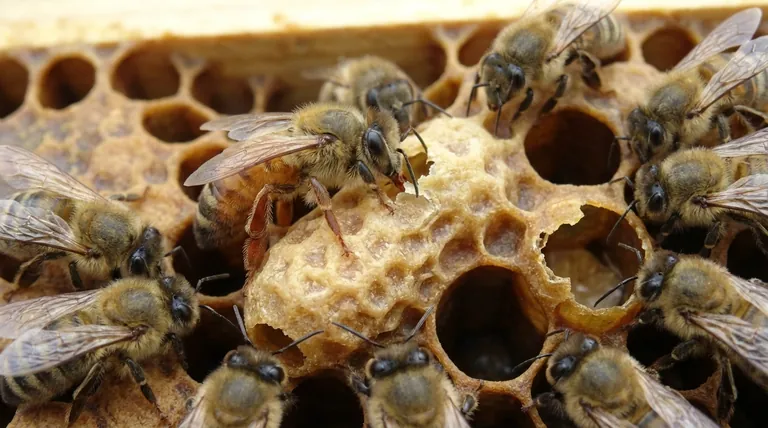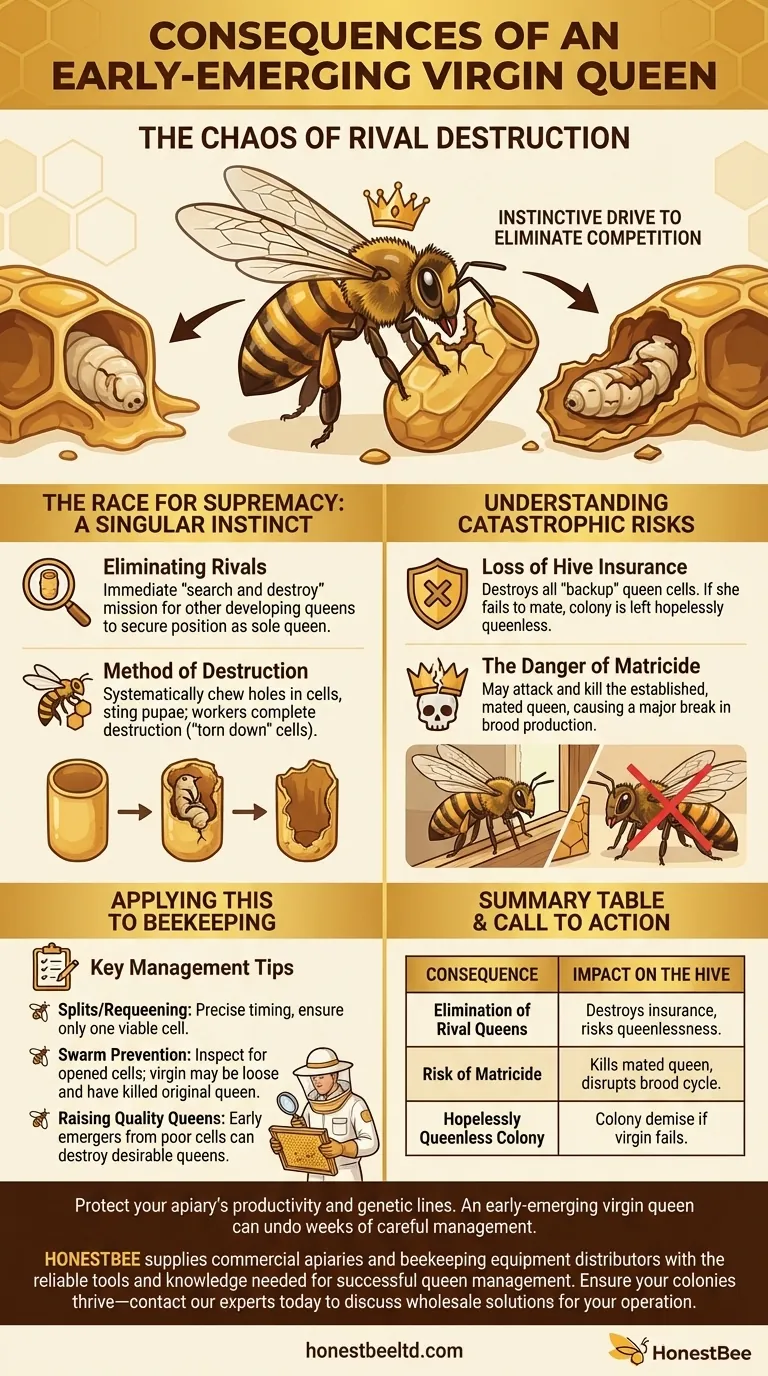In short, the primary consequence of an early-emerging virgin queen is chaos and the systematic destruction of her rivals. Her instinct is to secure her position as the sole queen, which she does by destroying any other queen cells and, in some cases, even killing the hive's established, mated queen.
The emergence of a virgin queen before her time is a critical event for a beehive. Her instinctive drive to eliminate all competition can prematurely destroy a colony's "backup" queens or even lead to the death of the current laying queen, putting the entire colony's future in jeopardy.

The Race for Supremacy: A Virgin Queen's Instinct
A newly emerged virgin queen is not a passive member of the colony. She is driven by a powerful, singular instinct: to become the only queen.
The Primary Objective: Eliminating Rivals
The first virgin queen to emerge from her cell immediately begins a "search and destroy" mission. Her goal is to find any other developing queens within the hive and eliminate them before they can emerge and challenge her.
This is a biological imperative designed to prevent the colony from being divided by multiple queens.
The Method of Destruction
She will systematically move from one queen cell to another. Upon finding a cell, she will often chew a hole in its side and sting the helpless pupa or pre-emergent virgin inside, killing it.
The worker bees will then typically finish the job, completely tearing down the now-defunct queen cell. This behavior is what beekeepers refer to when they see queen cells that have been "torn down."
Understanding the Catastrophic Risks
While this behavior is natural, it creates significant risks, especially in a managed hive where a beekeeper is trying to control the process.
Loss of Hive Insurance
When a colony creates multiple queen cells, it's a form of biological insurance. If one queen fails to emerge, is defective, or is lost on her mating flight, another is ready to take her place.
An early-emerging virgin destroys all these "backups." If she then fails to mate and return, the colony is left hopelessly queenless with no further options to raise a new queen.
The Danger of Matricide
Perhaps the greatest risk is that this instinct does not differentiate between a rival in a cell and the hive's current, mated queen.
In certain situations, particularly if the virgin is undersized, she can slip through the holes of a queen excluder. If she reaches the brood box where the old queen resides, she will almost certainly attack and kill her. This act is known as matricide.
This can undo a beekeeper's requeening effort or leave a strong colony suddenly without its productive, laying queen. The hive descends into a state of disruption until the new virgin can mate and begin laying, a process that takes weeks and causes a significant break in the brood cycle.
How to Apply This to Your Beekeeping
Understanding this ruthless instinct is key to managing your colonies, especially during splits, requeening, or swarm control.
- If your primary focus is making splits or requeening: Be precise with your timing. When introducing a queen cell, ensure it is the only viable one or protect it from rivals until you can confirm the old queen is removed.
- If your primary focus is swarm prevention: When removing swarm cells, inspect the frames carefully. An opened queen cell means a virgin may already be loose in the hive, and she may have already killed your original queen.
- If your primary focus is raising quality queens: Do not assume all queen cells are equal. An early emerger from a small, poorly drawn emergency cell can eliminate the more desirable queens you were hoping to cultivate.
Proactively managing queen cells is essential to prevent a single, early virgin from undermining the entire future of the colony.
Summary Table:
| Consequence | Impact on the Hive |
|---|---|
| Elimination of Rival Queens | Destroys all backup queen cells, leaving the colony with no insurance. |
| Risk of Matricide | May attack and kill the established, mated queen, causing a break in brood production. |
| Hopelessly Queenless Colony | If the virgin fails to mate, the hive has no way to raise a new queen, leading to its demise. |
Protect your apiary's productivity and genetic lines. An early-emerging virgin queen can undo weeks of careful management. HONESTBEE supplies commercial apiaries and beekeeping equipment distributors with the reliable tools and knowledge needed for successful queen management. Ensure your colonies thrive—contact our experts today to discuss wholesale solutions for your operation.
Visual Guide

Related Products
- Multi-Function Queen Roller Cage and Catcher
- Professional Multi-Functional Queen Bee Cage
- Durable Galvanized Steel Spring Queen Bee Cage
- Professional Queen Cage with Sliding Gate and Feeder Plug
- Professional Multi-Compartment Queen Cage with Sliding Lid
People Also Ask
- What are common problems during queen introduction? Ensure Hive Acceptance and Queen Survival
- What is sequestration, and how does it help bees reorient? A Safer Guide to Hive Relocation
- How should a queen cage be maintained over time? Ensure Queen Introduction Success
- What items are needed to place the queen bee's cage in the hive? A Guide to Successful Queen Introduction
- What is the procedure for safely removing attendant bees from a queen cage? A Step-by-Step Guide for Beekeepers



















